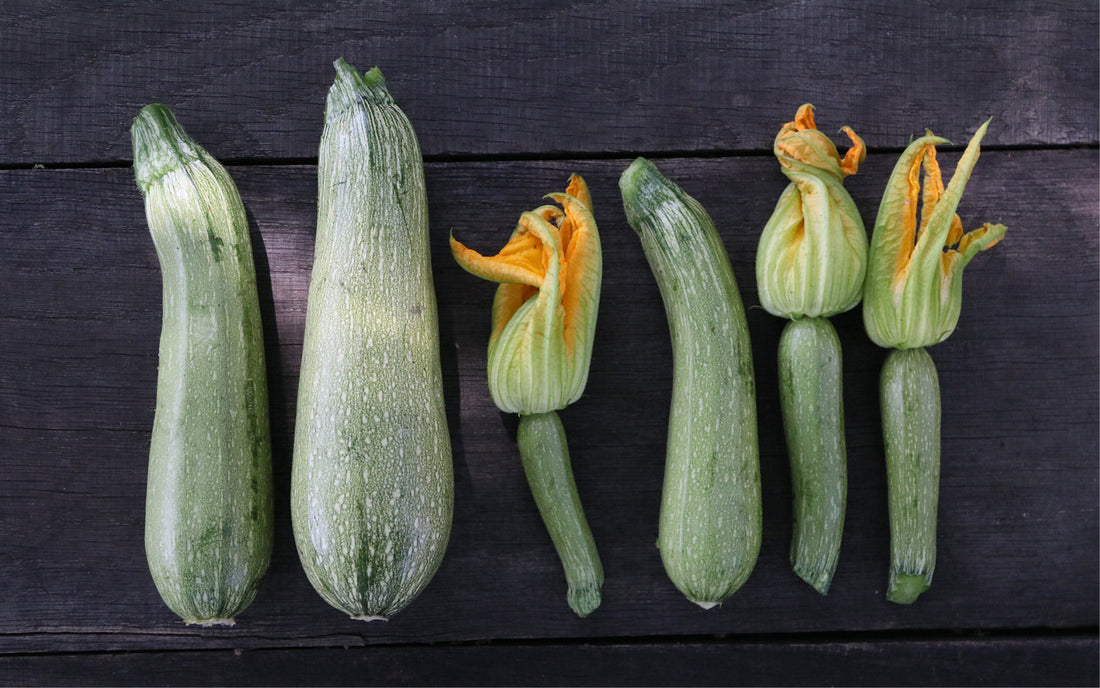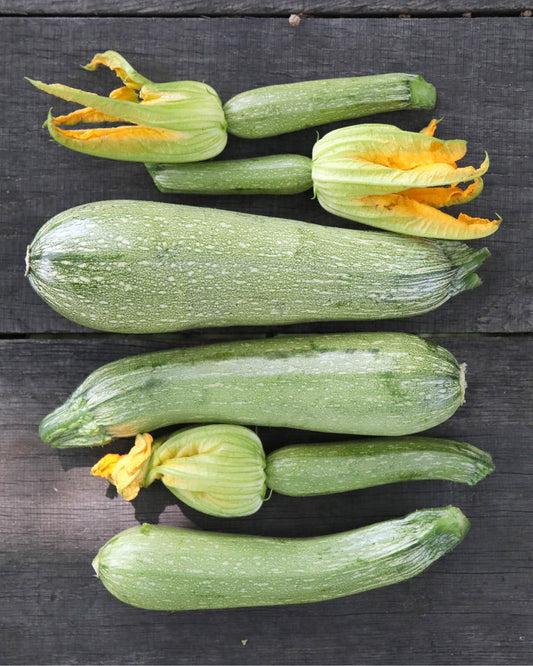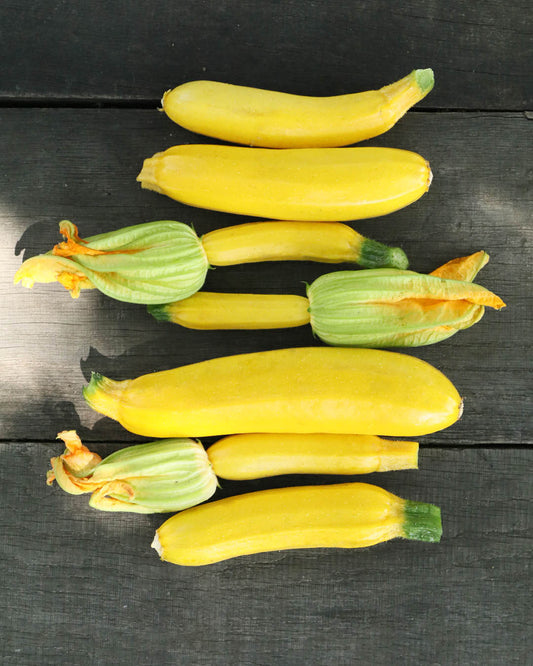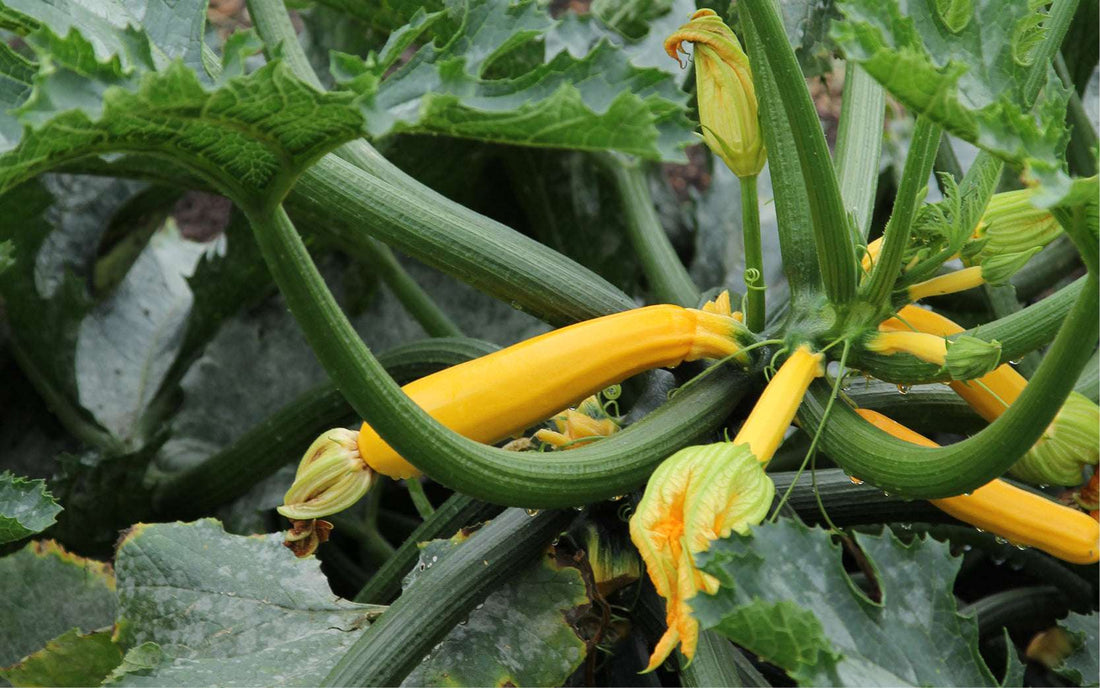zucchini
The zucchini plant, a member of the squash family, offers a wide variety of preparation options and is particularly popular among home gardeners due to its ease of cultivation. With proper care, you too can soon harvest bountiful zucchini in your garden!

Planting time – When is best?
Starting in mid-April, zucchini can be started on a windowsill or in a greenhouse. After the Ice Saints, the grown zucchini plants can be planted out in their intended location. Starting in mid-May – as soon as the soil has warmed up – you can also sow the plants outdoors; the plants develop quickly.
Growing zucchini – How does it work?
Either sow directly into the bed starting in May or grow the seedlings indoors. For this, two seeds should be placed in each pot with a diameter of at least 9 cm. The weaker plant is removed after a few days, and only the stronger one is planted in the bed in mid-May. Make sure the soil is warm when transplanting the zucchini seedlings. In the early stages, it's a good idea to protect the seedlings from snails with fleece.
Two to three plants are sufficient for a family's needs. Plant three seeds each at a distance of 1 to 2 meters. The distance from other crops in the bed should be approximately 50 cm.

Zucchini · 'Alberello' · BIO · Cucurbita pepo var. giromontiina · Saatgut von Gartenzauber
Zucchini 'Alberello' is a non-trailing variety with an open habit and abundant, early fruit set. The delicate, light green marbled fruits grow cylindrically and slightly curved. Their white, firm flesh has a fine texture and is exceptionally aromatic with a slightly buttery note. They are at their best when harvested at a height of 10-20 cm.
Our high-quality organic vegetable seeds are grown according to the strictest organic standards for a sustainable and healthy harvest.
Details:
Sowing indoors/greenhouse: mid-April to mid-June
Planting outdoors: mid-May to mid-July
Germination time: 7-14 days at 18-20°C
Sowing depth: 3 cm, dark germinator
Height: approx. 40 cm
Planting distance: 100 x 100 cm
Harvest time: mid-June to mid-October
Soil: loose, humus-rich, dry, permeable
Fertilization: Organic fertilizer, compost
Location: Sunny, partial shade
Water consumption: medium
Growing tips:
If zucchini are grown early, they should never be pricked out, as their roots are far too sensitive. Therefore, they should be sown individually in pots and later repotted or planted with the entire root ball. They do not tolerate frost and should only be planted outdoors after the Ice Saints. Zucchini are heavy feeders and prefer nutrient-rich soil with plenty of compost and humus. They should also be top-fertilized with organic liquid fertilizer during the growth phase. For good fruit set, always plant at least two young plants, which should be protected from snails. Regular and generous watering is important. In wet summers, the plants are easily attacked by fungi. A preventative treatment with plant strengtheners can counteract this.
With regular harvesting, new fruits will continue to grow until autumn.
Mixed culture:
Good neighbors: beans, peas, chard, corn, onions, petunias, marigolds
Bad neighbors: tomatoes, cucumbers, potatoes, radishes
Use:
Raw, steamed, grilled, boiled, baked, and fried, they go well with both savory and sweet dishes. There are no limits to creativity.
Bag contents:
approx. 15 grains
Store in a cool, dry place.
Location – Where is best?
Deep, humus-rich, and nutrient-rich soils that retain moisture well are best. Zucchini also prefer ample space and a sunny, warm location.
Care – What needs to be done?
Zucchini are heavy feeders and benefit from two to three applications of compost during the growing season. They require sufficient water, especially during extreme summer heat. Therefore, please remember to water regularly, deep down to the roots, preferably with slightly warm water.
Harvest – What should you consider?
Zucchini are usually harvested three months after sowing. You can either separate the zucchini from the stem with a twisting motion or use a knife. The fruits should ideally not grow larger than 15 to 20 cm, as otherwise their delicate flavor will suffer considerably. If you harvest regularly, the plants will diligently produce new zucchini. Zucchini have both female and male flowers – those with stems are male. These never produce fruit, but they taste delicious. It's best to harvest them before the flowers open. Female zucchini, on the other hand, produce tiny zucchini flowers.
Mixed culture – What are good neighbors?
Beans, peas, chard, corn, onions, petunias, and marigolds all thrive with zucchini. Avoid tomatoes, cucumbers, potatoes, or radishes as companion plants.

Zucchini · 'Sativa Auslese' · BIO · Cucurbita pepo var. giromontiina · Saatgut von Gartenzauber
Zucchini 'Sativa Auslese' is a bushy, open-growing variety with abundant, early fruit set. The light-yellow fruits grow cylindrically, are slightly curved, and have a delicate skin. Their white, firm flesh has a fine texture and a good flavor. Harvest young!
Our high-quality organic vegetable seeds are grown according to the strictest organic standards for a sustainable and healthy harvest.
Details:
Sowing indoors/greenhouse: mid-April to mid-June
Planting outdoors: mid-May to mid-July
Germination time: 7-14 days at 18-20°C
Sowing depth: 3 cm, dark germinator
Height: approx. 80 cm
Planting distance: 100 x 100 cm
Harvest time: mid-June to mid-October
Soil: loose, humus-rich, dry, permeable
Fertilization: Organic fertilizer, compost
Location: Sunny, partial shade
Water consumption: medium
Growing tips:
If zucchini are grown early, they should never be pricked out; their roots are far too sensitive. Therefore, they should be sown individually in pots and later repotted or planted with the entire root ball intact. They do not tolerate frost and should only be planted outdoors after the Ice Saints. Initially, the plant produces only male flowers, which must remain on the plant. Only when temperatures are right and the plant is strong enough will it produce female flowers, which can be identified by the ovary.
Zucchini are heavy feeders and prefer nutrient-rich soil with plenty of compost and humus. They should also be fertilized with organic liquid fertilizer during the growth phase. For good fruit set, at least two young plants should always be planted, which should be protected from snails. Regular and generous watering is important. In humid summers, the plants are easily attacked by fungi. A preventative treatment with plant strengtheners can counteract this.
With regular harvesting, new fruits will continue to grow until autumn.
Mixed culture:
Good neighbors: beans, peas, chard, corn, onions, petunias, marigolds
Bad neighbors: tomatoes, cucumbers, potatoes, radishes
Use:
Raw, steamed, grilled, boiled, baked, and fried, they go well with both savory and sweet dishes. There are no limits to creativity.
Bag contents:
10 grains
Store in a cool, dry place.
Botany – What kind of plant is this?
Zucchini belongs to the squash family. However, many varieties do not trail like pumpkins, but form a large bush that can cover an area of over one square meter. Unlike pumpkins, zucchini are harvested and eaten young and unripe. Zucchini are not only useful plants, but also ornamental. The fruits are available in yellow, light and dark green, as well as striped. The shape also varies depending on the variety, from oblong to round.
Cultural history – How did the zucchini come to us?
The name "zucchini" comes from Italian and means "small pumpkin." However, these large, crunchy fruits originate in North and Central America, where they have been cultivated for thousands of years as one of the various pumpkin varieties. Christopher Columbus brought the zucchini to Europe, where it was cultivated primarily in Southern Europe in various varieties. It was relatively late, not until the 1970s, that zucchini began to be cultivated in Germany. Due to its simplicity, it is very popular with hobby gardeners and thrives even in the temperate Central European climate. The main zucchini growing areas are China, India, and the Mediterranean.





































































































